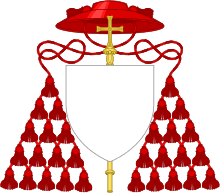Fernando Cento
| Styles of Fernando Cento | |
|---|---|
 | |
| Reference style | His Eminence |
| Spoken style | Your Eminence |
| Informal style | Cardinal |
| See | Velletri-Segni (suburbicarian see) |
Fernando Cento (10 August 1883 – 13 January 1973) was a Cardinal of the Catholic Church who served as Major Penitentiary of Apostolic Penitentiary.
Fernando Cento was born in Pollenza, Italy. His parents were Evaristo Cento and his second wife, Ermelinda Andreani. He had a half-sister, Rosa, and a brother, Vincenzo.
Education
He was educated at the Seminary of Macerata from 1893 to 1905, where he was taught philosophy and theology, and later at the Pontifical Gregorian University, where he studied canon law. He continued his studies at La Sapienza University, Rome where he obtained a doctorate in letters. He received the diaconate on 17 December 1905 in the basilica of the Madonna della Misericordia.
Priesthood
He was ordained on Saturday 23 December 1905 in Macerata; he had to obtain a dispensation for not having yet reached the canonical age of 23 years required to be ordained a priest. He served as professor of literature at the Seminary of Macerata; and of philosophy at the State Institute of Macerata from 1906 to 1916. He demonstrated excellent qualities as a preacher in several Italian dioceses. He was called to military service when Italy entered the First World War in 1915 and was attached to the military hospital of Ancona from 1915 to 1917. He was created Privy chamberlain of His Holiness on 15 November 1917.
Episcopate
He was appointed Bishop of Acireale by Pope Pius XI on 22 July 1922. He was consecrated on 3 September 1922, by Cardinal Giovanni Tacci Porcelli, Secretary of the Congregation for the Oriental Church, assisted by Domenico Pasi, Bishop of Macerata-Tolentino, and by Placido Ferniani, Bishop of Ruvo e Bitonto. He was promoted to Titular Archbishop of Seleucia Pieria on 24 June 1926 and was appointed nuncio to Venezuela four days later. He remained in Venezuela until transferred to Peru on 26 July 1936. As well as his duties in Peru he was charged with the affairs of the church in Ecuador, which did not have diplomatic relations with the Holy See for nearly forty years. He was named nuncio to Ecuador on 25 July 1937, after having successfully negotiated the modus vivendi with the Ecuadorian government which established diplomatic relations between the two parties. He was Special Envoy to the inauguration of Manuel Prado y Ugarteche as President of Peru, on 8 December 1939, to the inauguration of Juan Antonio Ríos Morales of Chile on 2 April 1942, and to the inauguration of José Luis Bustamante y Rivero as President of Peru on 28 July 1945. He remained in Latin America until he was appointed nuncio to Belgium and Luxembourg on 9 March 1946. He served as Special Envoy to the coronation of Queen Elizabeth II of the United Kingdom on 2 June 1953 and became Nuncio to Portugal in the same year.
Cardinalate
He was created Cardinal-Priest of Sant'Eustachio (deaconry elevated pro hac vice to title) by Pope John XXIII in the consistory of 15 December 1958. He was appointed as Major Penitentiary of Apostolic Penitentiary on 12 February 1962. He attended the Second Vatican Council. One of his roles was reporting on the practice of indulgences, a report that was not favorably received by many at the council.[1] He participated in the conclave of 1963 that elected Pope Paul VI. He was elected to the order of Cardinal bishop, taking the title of the suburbicarian see of Velletri on 23 April 1965. He resigned his post of Major Penitentiary in 1967. He lost the right to participate any future conclaves on becoming over eighty years old on 1 January 1971.
Death
He died in 1973 in Rome. On that same day, Pope Paul visited the chapel where the body of the cardinal lay. The funeral mass, celebrated by Luigi Punzolo, titular archbishop of Sebastea, apostolic administrator of Velletri, took place in the patriarchal Vatican basilica on 16 January. Cardinal Luigi Traglia represented the pope in the final commendation. A large number of cardinals, archbishops and bishops of the Roman Curia, as well as from Macerata, Pollenza and Acireale, attended the funeral. A funeral mass in the cathedral of Macerata was presided over by Bishop Ersilio Tonini of Macerata, concelebrated by 100 priests and numerous bishops. The funeral in Pollenza was a demonstration of the esteem of its population for the late cardinal. His mortal remains were buried in the parish church of S. Antonio, Pollenza, where he had celebrated his first mass.
References
- ↑ O'Malley, p. 280.
- O'Malley, John, What Happened at Vatican II, Cambridge, MA: The Belknap Press of Harvard University, 2008. ISBN 978-0-674-03169-2
| Catholic Church titles | ||
|---|---|---|
| Preceded by Arcadio Larraona Saralegui |
Major Penitentiary of Apostolic Penitentiary 12 February 1962 – 7 April 1967 |
Succeeded by Giuseppe Ferretto |
| Preceded by Clemente Micara |
Cardinal-Bishop of Velletri-Segni 23 April 1965 – 13 January 1973 |
Succeeded by Ildebrando Antoniutti |
|